Compare and Contrast Essay: Homeschooling vs Public Schooling
| 📌Category: | , |
| 📌Words: | 596 |
| 📌Pages: | 3 |
| 📌Published: | 25 March 2022 |
A lot of people like to debate what type of schooling is best for their children. Public schools provide an environment with different types of people and help students adapt to what the world is like. Students learn very useful social skills and practice them every day to be prepared for future opportunities. Homeschooling, on the other hand, seems like a better option for many students as they struggle to balance their schedule, more often at the high school age. Now, especially with the pandemic going around, many parents are switching their children to the homeschool option.
Money can very often be an issue when parents decide on their child’s schooling. Public schools are typically less costly than homeschool curriculums. The reason why many parents can’t get homeschool, even if they want to, is mostly because of the cost. It is very stressful juggling a job and children in need of an education, and it just seems simpler to send them to public school.
Something that moves parents to deciding on homeschool for their children, is concern for their safety. Public schools may have drugs going around and people getting discriminated against and bullied. According to the CDC, 1 in 5 high school students reportedly experienced school bullying. That leads to a higher risk of suicidal thoughts and even attempts. And parents are trying to keep their children feeling safe in their home.
Being able to socialize in a healthy way is important to learn from a young age, so we can apply those skills in the future when you need to apply for a job interview. Public schooling includes more socialization than homeschool. Homeschool can teach some skills, but in public schooling it is “built in”, as students are pretty much required to communicate with classmates and teaching personnel. Some homeschooled students tend to feel very lonely. I myself have no friends, and sometimes think to myself that it would be way better to actually learn to socialize in a social setting instead of cooped up in a home sitting at a desk.
Schedules can be very important for teens as they start to be more involved in activities and even work. Public schools are on a pretty tight schedule and everything is laid out specifically by hours. While in homeschool, the schedule is very flexible and changeable. Having a pretty flexible schedule also helps with job opportunities. If a restaurant wants you to work from 8 to 10 AM, on a weekday, it would be really hard to juggle this and public school. While for homeschool, you can just watch the daily lessons later in the day.
Though there are many differences in homeschooling and public schooling, they both teach relatively the same subjects. Sometimes more or less, as it depends on if it is a religious based homeschool or public school. They both offer the basics, such as math, science, reading, writing (English in older grade levels), and also foreign language can be an option for older grades. In many homeschool curriculums there are plenty of options for Performing Arts and Family and Consumer Science. Though public schools may offer more in terms of elective courses, variety of sports and other extracurricular activities. Also, both options may use many types of media and sources to teach in a more fun or “hands-on” way. If it is alright with your on-site teacher, you can get creative while doing homeschool too. It isn’t as boring as some people perceive it to be. There are plenty of classes like art and science that offer hands-on activities.
Both schooling options can have downsides, and great sides to them. Money, safety, being social, and scheduling are all important factors in a healthy school experience, but at the end of the day, I believe what matters most is what you feel like fits you best and what makes you most comfortable.

Related Samples
- Homeschooling is it really the best option?
- Essay on Banning Cell Phones in School
- Schools Need to Reopen Essay Example
- Essay Sample about Procrastination in School
- Narrative Essay Sample. I am Procrastinating Perfectionist
- Education, Knowledge and Learning Essay Example
- Importance Of Equity In Education
- Benefits and Disadvantages of Online Learning Essay Example
- Argumentative Essay: College Should Be Free
- Essay On Stress In High School
Didn't find the perfect sample?

You can order a custom paper by our expert writers
Homeschooling Vs Public School
This comparative analysis will delve into the differences and similarities between homeschooling and public schooling. It will discuss the advantages and disadvantages of each educational approach, covering aspects such as academic performance, socialization, curriculum flexibility, and parental involvement. The piece will draw on research studies, expert opinions, and anecdotal evidence to provide a balanced view of both educational methods. It will also consider the impact of recent global events, such as the COVID-19 pandemic, on perceptions and choices regarding homeschooling and public schooling. PapersOwl showcases more free essays that are examples of Behavior Modification.
How it works
- 1 Homeschooling
- 2 Financial Basis
- 3 Availability and Diversity
- 4 Socialization
- 5 Environment
- 6 Education
- 7 Conclusion
Homeschooling
Education is an essential and determines the future of every child. In order to give children a bright future and a good education, parents must choose the best type of schooling for their children. The main education systems are public school, private school and homeschool. Homeschooling is led and managed by parents and public school is led by the government and qualified teachers. The real question is, which is better? While homeschooling has its benefits, public schooling is superior because it prepares children and teens for the real world in many ways.
People may believe that homeschooling is better because of negative influence and effects from public schools; however, it is better for children to be exposed to certain things early on than later in life. Taking the time to learn about the benefits and outcomes of public school over homeschool is important. Public schooling is cheaper, reflects the real world, and prepares young individuals for future obstacles which may occur.
Financial Basis
To start off, public schooling is funded by the government which makes it more affordable than homeschooling. The government guarantees all children education, no matter the financial status. However, there are private schools that can be very expensive; the most common education systems are public schooling and homeschooling. Reporter Amy Esbenshade Hebert, explained that “Whatever the advantages of home-schooling, saving money isn’t necessarily one of them. Add up the expense on books, curricula, tutors, field trips — not to mention the loss of a second income if one parent becomes the full-time teacher — and the cost of home-schooling can easily rival paying private-school tuition” (Herbert, 2007, p. 88). For public school, normally, buying supplies once or twice a year is required. But for homeschool, spending an abundant amount on the curriculum alone, not to mention textbooks and supplies including wifi and a device or computer are essential. There are costs associated with both education systems, but homeschool is distinctly more expensive than public school. Although some people might complain about the added expenses of supplies and participation in athletics, public schooling are still much more budget friendly than homeschooling.
Availability and Diversity
In addition, public schools provide access of an education for any child no matter academic performance, income level or disability. Public schools ensure that every student has the same opportunities regardless. Given that any child is admitted, they are likely to have classmates that do not act, think, or look like them. The diversity of classmates can be a great learning experience. It exposes children to different cultures and attributes. While there is not much exposure to the diversity with homeschooled, many homeschooling programs offer dual enrollment. The Coalition for Responsible Home Education stated that
In some states, homeschooled students participate in public school athletics alongside other students. In other states, they are banned from participating. In other states, homeschooled students are barred from participation in public school athletics. The trend in recent years has been towards allowing participation, and the states are today split fairly evenly down the middle on the issue. (¨Homeschool¨, 2018, para. 1)
Although this has good points as to why and how public schooling programs are available, not all homeschooling programs have this option available in certain areas and it is not always the best economical choice.
Socialization
Furthermore, conventional schooling and homeschooling both offer their own respective advantages in preparing children for the social demands of the real, adult world. It is possible to become socially well adjusted through private schooling and homeschooling. However, it is challenging and encompassing part of a child’s formative years. Public school is a major place where kids learn to socialize, how to behave around their peers and teachers, and how to generally just communicate and interact well. Students have the ability ability to interact with people of diverse ages and beliefs. Contrarily, Calvert Education explains,
For one thing, homeschoolers do not have the same exposure to peer pressure and bullying, both of which are tied to poorer academic performance and lower self-esteem. Parents often decide to homeschool because they do not want their child’s values to be defined by their peers or for their children to face social ridicule or bullying. In private or public schools, the pressure to “fit in” or achieve a perceived level of social status among classmates can be quite great. (“Homeschooling” 2017, Homeschool Socialization Sect. para. 2-3)
As much as I would agree that these are possible disadvantages of public school, every person will go through some type of pressure or negative things in his or her lifetime. Public schooling is a way to become familiar of the real world and be exposed to problems and certain circumstances. Bullying and social ridicule are very negative and can result in many outcomes; however, they are real and whether someone is homeschooled or not, they will or may face negative circumstances in their lifetime. With the experience of public schooling, individuals may be able to handle it differently and react differently than people who are homeschooled. Experience is a number one factor that can change how someone reacts to, copes with, and manages a situation. Homeschooling limits children’s interaction with others, as well as it limits their contact and association with diverse individuals.
Environment
In addition, the main difference between homeschooling and public schooling is the environment. In homeschooling, there are no distractions because children are studying at their own risk. David R. Hodge stated, “for instance, the most widely cited reason by parents which accounted for 88% of all homeschooled students was concern about school environments and the associated detrimental effects related to substance use, peer pressure, etc” (Hodge, 2017, p. 274). Parents feel that the public school environment is dangerous and will cause their child to rebel. Also that it may teach a different set of values and beliefs than what parents believe and want to instill in their child. In a homeschooling setting, parents are able to watch over their child, help them develop, and teach them morals. Homeschooling provides students with a calm, safe, and comfortable environment. However, even though public school classrooms do not always have the same calm and peaceful atmosphere, the disarray of the classrooms is helpful to children. This is because, in reality, the real world is not so calm and peaceful. Therefore, the children who live sheltered and preserved from real life are the ones who commonly have difficulty adjusting to reality. It is necessary for children to learn to interact and work with one another to build the dynamic skills needed for the real world. Both homeschool and public school provide helpful opportunities for children to learn, but public school is more impactful in assuring a children’s future success and adjustment to the real world.
Lastly, public schools provide children with certified teachers who are committed educators. Where in homeschooling, children are taught by their parents who only need a highschool diploma or G.E.D. to homeschool. Parents do not have the same level of education or experience as teachers. As well as, parents have to be fully dedicated to their child’s’ education for them to succeed. Many parents have jobs; therefore, balancing a job while trying to educate their children can be difficult. In addition, while parents are directly involved in the education of their children, it may be difficult to teach certain subject without experience. Therefore, homeschoolers may have to invest in a tutor or educational professional for support which defeats the whole purpose of homeschooling. Although homeschooling may teach a student to become more independent and do things on his or her own, it is not always best to just rely on oneself. Tara Jones expresses that “it may be that home-educating parents have more opportunities to be influential, supportive and encouraging in their children’s education as well as having more control and power over their children’s learning” (Jones, 2013, p. 117). However, she also contraversed that “home-educating families argue that they are not able to access the funding and services that schools have in order to educate their children” (Jones, 2013, p. 118). Therefore, even though homeschooling allows parents to have more jurisdiction and opportunities for their children, many may struggle to provide his or her child with services and education the education they need.
To conclude, public schooling has its advantages financially, socially, environmentally, and educationally. However, it is important that both the advantages and disadvantages of public schooling and homeschooling are taken into account. Homeschooling can have a more direct role on a child’s daily learning and help protect a child from bullying or other negatives aspects of reality. As well as, being in a friendly environment, having less distraction from students, and becoming more self motivated and independent are all aspects of homeschooling. However, children lose out on social interaction with peers while homeschooled.
In addition, fewer resources such as technology that may be available in public school are not provided and with parents having to dedicate time and money to homeschooling it can result in a loss of income or reduced working time. Not only do students that are homeschooled miss out on the interaction with peers and diversity of people, they lack the real world experiences which are the reasons why parents decide to homeschool their children in the first place. With homeschooling, parents or people in general are afraid of the negativity that is exposed to children in public schools. This includes, bullying, violence, peer pressure, and many other negatives influences. Furthermore, while homeschooling can provide a wide variety of courses and curriculums that are not available with public school, homeschooling is much more expensive than the traditional government funded public school. Whether the differences between homeschooling and public schooling it all comes down to each parent’s learning goals for their children.
Cite this page
Homeschooling vs Public School. (2021, Jul 05). Retrieved from https://papersowl.com/examples/homeschooling-vs-public-school/
"Homeschooling vs Public School." PapersOwl.com , 5 Jul 2021, https://papersowl.com/examples/homeschooling-vs-public-school/
PapersOwl.com. (2021). Homeschooling vs Public School . [Online]. Available at: https://papersowl.com/examples/homeschooling-vs-public-school/ [Accessed: 29 Jun. 2024]
"Homeschooling vs Public School." PapersOwl.com, Jul 05, 2021. Accessed June 29, 2024. https://papersowl.com/examples/homeschooling-vs-public-school/
"Homeschooling vs Public School," PapersOwl.com , 05-Jul-2021. [Online]. Available: https://papersowl.com/examples/homeschooling-vs-public-school/. [Accessed: 29-Jun-2024]
PapersOwl.com. (2021). Homeschooling vs Public School . [Online]. Available at: https://papersowl.com/examples/homeschooling-vs-public-school/ [Accessed: 29-Jun-2024]
Don't let plagiarism ruin your grade
Hire a writer to get a unique paper crafted to your needs.

Our writers will help you fix any mistakes and get an A+!
Please check your inbox.
You can order an original essay written according to your instructions.
Trusted by over 1 million students worldwide
1. Tell Us Your Requirements
2. Pick your perfect writer
3. Get Your Paper and Pay
Hi! I'm Amy, your personal assistant!
Don't know where to start? Give me your paper requirements and I connect you to an academic expert.
short deadlines
100% Plagiarism-Free
Certified writers
Home School Versus Public School Essay
- To find inspiration for your paper and overcome writer’s block
- As a source of information (ensure proper referencing)
- As a template for you assignment
Introduction
Similarities and differences between public schools and home schools, reference list.
Home schooling is the education of students at home by parents or tutors instead of learning in the formal school setting. Public schools are institutions of learning that are offered to all students by the government and that are paid for by the state taxes, either partially or in full. These two types of schooling have similarities and differences in the way they are run. This paper explores the main similarities and differences between home schools and public schools.
These two types of schooling have some similarities. Firstly, the overall goal in both types of learning is to give education to the students and to ensure academic excellence. Learning takes place to ensure that students in both public and home schools get a good education.
Both types of schooling involve the student sitting down with an instructor and receiving instructions. In home schooling the instructor can be a parent or a tutor while in public schools, the instructor is a teacher. In addition, students in both schools use the same resources to do research, such as the libraries, Internet, and museums. Moreover, students from both schools take field trips by visiting art exhibitions and museums. Another similarity is that both types of schooling use a curriculum to guide them.
Public schools use a curriculum designed by the public education authorities while in home schooling, the parent designs a suitable curriculum or uses one that has already been designed and proven to be successful. Furthermore, in both types of schooling, the student has to study and do quizzes and tests to determine the level of understanding the content. These two types of schools are also similar in that most of the subjects taught in public schools and home schools are the same.
Even though the parent of home-schooled children can choose the learning content most suitable for the child, some content such as algebra and many others are mandatory. Many home schools will also use books that correspond to those used in public schools in terms of content and grade level. Another similarity is that in both there are laws that regulate learning. There are laws that govern both public schools and home schooling, and they need to be adhered to in terms of the learning content.
Besides, when entering college, both home schooled and public schooled students take the same standardized tests (Cai, Reeve and Robinson, 2002). However, these two types of schools differ in various ways. In public schools the student learns within a group setting and is therefore likely to learn social skills through interacting with other students. This enables the student to learn to socialize with other members of the society and be able to interact in the real world.
Students in public schools are encouraged to work with others and solve problems as a team and these interactions give them knowledge and experience. In home schooling, the student learns alone and there is no interaction with other students. They do not get the opportunity to interact with their peers during learning. Home schooled students are encouraged to develop individual styles and explore their own interests.
Therefore, home schooled students may have problems interacting and relating with other members of the society in the real world. Another difference is that students in public schools may perform poorly in class due to distractions such as peer pressure. In home schooling, the students are shielded from any distractions that may come up in a learning environment and therefore they are more likely to perform well (Cai, Reeve and Robinson, 2002).
In home schooling, the student can choose the environment that is most conducive for learning. However, the learning environment in public schools is rigid and cannot be adjusted. Moreover, in public schools the curriculum is designed by the public education authorities. They also decide the books to read and the subjects that should be done in each grade.
In home schooling, the parent can develop a curriculum for the child or choose one from the ones already designed. The parent also chooses the learning materials that are most suitable for the child. Another difference is that in home schooling, the children can be taught at their own level and with the learning styles most suitable to them. They can also learn at their own suitable time. In public schools, learning is scheduled by the school and is therefore not flexible.
All Students in public schools are taught with the same learning styles and therefore some of them might not learn effectively (Berends, 2009). In home schooling, the individual student’s learning needs are met because there is a one-on-one teaching. There is only one student being taught and therefore the instructor gives him/her all the attention. The parent can be able to monitor the progress of the student and further explain concepts that the student has not understood. The student is also taught at his/her learning pace.
In public schools, the teacher has to pay attention to many students and therefore may not be able to monitor the progress of each individual student. Understanding and meeting the needs of all individual students in a public school is difficult. All the students do not learn at the same pace and therefore the class might move on while some students have not yet understood a concept (Cai, Reeve and Robinson, 2002).
In public schools, there are many teachers with expertise in different subjects. In home schooling, the parent may not have enough knowledge and expertise to teach all the subjects. Another difference is that public schooling keeps the child away from the parents for long periods of time and therefore reduces family bonding.
In home schooling, parents and students are together all the time. Home schooling strengthens family bonds as the members of the family are always in close contact. Moreover, in public schools, extra-curricular activities are available to the students.
Students in public schools engage in sports and other activities after the class hours. This is not the case in home schooling as there are no peers for the home schooled student to play with at home. Another difference is that home schooling is more expensive than public schooling.
This is because public schools are mostly free and learning materials are provided. In home schooling, the parent has to acquire learning materials for the student and may sometimes hire a tutor if he/she does not have enough time or expertise to teach the child in a certain subject area (Berends, 2009).
Public schools and home schools have both similarities and differences and each has its pros and cons. Each individual student has unique learning needs and some can learn best in a public school while others are best suited to a home school. Therefore, parents should critically weigh each option in order to ensure that their children learn in a school that is best suited to them.
Berends, M. (2009). Handbook of Research on School Choice . New York: Taylor & Francis.
Cai, Y., Reeve, J. and Robinson, D.T. (2002). Home schooling and teaching style: Comparing the motivating styles of home school and public school teachers. Journal of Education Psychology, Vol. 94(2), pp. 372-380.
- Home vs. Public Schooling: Middle Ground Argument
- The Arguments and Debates of the Home Schooling System
- Pre-Schooling Before Kindergarten Admission
- Education as a Tool for Creating a New Society That Is Democratic, Equitable, Humane, and Informed
- Assistive Technology in Education
- The Peculiarities of Transition Planning
- Effective Teaching of Reading in Education
- Compare and Contrast Private and Public Schools in Saudi Arabia
- Chicago (A-D)
- Chicago (N-B)
IvyPanda. (2018, October 31). Home School Versus Public School. https://ivypanda.com/essays/home-school-versus-public-school/
"Home School Versus Public School." IvyPanda , 31 Oct. 2018, ivypanda.com/essays/home-school-versus-public-school/.
IvyPanda . (2018) 'Home School Versus Public School'. 31 October.
IvyPanda . 2018. "Home School Versus Public School." October 31, 2018. https://ivypanda.com/essays/home-school-versus-public-school/.
1. IvyPanda . "Home School Versus Public School." October 31, 2018. https://ivypanda.com/essays/home-school-versus-public-school/.
Bibliography
IvyPanda . "Home School Versus Public School." October 31, 2018. https://ivypanda.com/essays/home-school-versus-public-school/.
Essay Service Examples Education Homeschooling
Homeschooling Vs Public Schooling Essay
- Proper editing and formatting
- Free revision, title page, and bibliography
- Flexible prices and money-back guarantee

Frequently Asked Questions
Similarities Between Homeschool And Public School
- both can take trips or vacations during the school year
- in public schools, taking time off is more limited for children, but it is still able to be done
- the variety of curriculum choices (home economics, astronomy, and photography just to name a few).
Our writers will provide you with an essay sample written from scratch: any topic, any deadline, any instructions.
Cite this paper
Related essay topics.
Get your paper done in as fast as 3 hours, 24/7.
Related articles
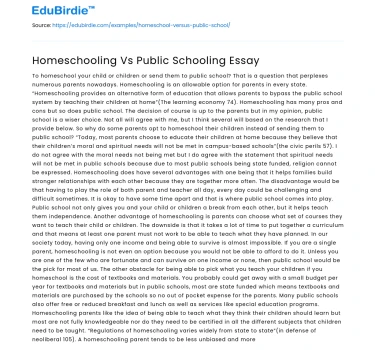
Most popular essays
- Homeschooling
In America, there are many modes of education. Homeschooling, public schools, private schools and...
To homeschool or otherwise to homeschool, which is a challenging concern which many mothers and...
Education plays a vital and serious role in our cutting-edge society. Lots of parents are urged to...
Education has been a very important issue for many individuals in today’s society. For some having...
Homeschooling is the process of educating children at home rather than inside a public school...
- Perspective
The teacher qualification of American homeschoolers is a key issue that concerns the survival of...
- Conversation
Annabel, a 42-year-old educator at the institute of education, university of London, focuses on...
You might like to consider home schooling them when you have a kid who is fighting in traditional...
Terrible schooling will cripple your children's alternatives. They simply may result in lousy work...
Join our 150k of happy users
- Get original paper written according to your instructions
- Save time for what matters most
Fair Use Policy
EduBirdie considers academic integrity to be the essential part of the learning process and does not support any violation of the academic standards. Should you have any questions regarding our Fair Use Policy or become aware of any violations, please do not hesitate to contact us via [email protected].
We are here 24/7 to write your paper in as fast as 3 hours.
Provide your email, and we'll send you this sample!
By providing your email, you agree to our Terms & Conditions and Privacy Policy .
Say goodbye to copy-pasting!
Get custom-crafted papers for you.
Enter your email, and we'll promptly send you the full essay. No need to copy piece by piece. It's in your inbox!

Homeschool vs Public School: Similarities & Differences
The next school year is right around the corner, and you may be trying to decide between homeschooling or sending your kids to public school. It is an important decision, and both can benefit children in different ways.
What are the similarities and differences between homeschool vs public school?
Both homeschools and public schools utilize curriculum and online resources to teach skills, and students in either environment can be required to participate in standardized testing. However, homeschools and public schools differ in:
- Parental Control and Workload
- Class Sizes
- Students’ Academic Readiness
Understanding how homeschooling and public schooling are alike and how they differ is crucial to making a sound decision on what best fits your family. Below are key similarities and differences of homeschool versus public school as you explore both options.
How Are Homeschool and Public School Similar?
Standardized testing may be required .
Public schools are known for requiring state-mandated standardized testing, but homeschooling may not exempt your child from the same criteria. As of today, 24 states require some form of nationally standardized achievement testing to be performed annually. The tests are designed to:
- Test the students in the categories of mathematics and English Language Arts
- Measure academic achievement every year
- Determine the national percentile rank for individual students
Homeschooling parents who live in one of the 24 testing states must keep a record or portfolio of their child’s test scores and have it ready to present to the state if requested. Public schools take care of these records for the parent.
Teachers and Homeschooling Parents Use Online Resources
Whether at home or in a traditional public school, the digital age is in full swing. No matter the age, efficiency level, or subject matter, there is an online program that can support the teacher and help the student learn more effectively.
Federal and state governments provide funding for resources in public schools but homeschool parents do not receive funding with the exception of a few states that offer a tax break.
As a result, homeschool parents are conscientious about finding affordable resources and using free online tools, such as setting up a Google Classroom and curating online resources.
How Are Public Schools and Homeschool Different?
Everyone knows that homeschool and public schools are different, but to what extent? Is there that much of a divide between the two experiences? Breaking it down to a few critical factors may give you the answer.
| Family-funded (exception of three states listed below for tax incentives) | Taxpayer-funded | |
| Parent controls curriculum | Local Education Agency controls curriculum | |
| Parents must teach, keep good records, and plan extracurricular activities. | Parents are not responsible for teaching, record keeping or planning activities. | |
| Students generally score the same or better on standardized achievement testing | Students generally score lower on standardized achievement testing | |
| One-to-one or small group attention | Classroom of 25 to 30 students |
The Cost of Homeschooling is Paid Out-of-Pocket
Public school is free for the student in terms of out-of-pocket expenses, but that is not to say there is no cost. Taxpayers pay an average of $10,615 per student each year. These numbers can range from as low as $6,000 in states like Utah and as high as $18,000 in more expensive states like New York.
Homeschooling is funded by the student’s family and can range anywhere from $250 to $2500 per student every year. Families who homeschool multiple children could spend more depending on the amount spent on the following:
- Materials
- Meals and snacks
- Extracurricular sports teams or activities
- Gas for planned and unplanned field trips
Additionally, in most states, families cannot claim compensation for homeschooling on their taxes. The only exceptions are Illinois, Minnesota, and Louisiana. In these states, homeschooling families can claim a tax credit.
Parental Involvement is Not Required with Public Schools
Parents of public school children are strongly encouraged but not required to be a part of their children’s educational experience. This allows both parents of the household to work outside of the home to provide more income.
Homeschooling a child can take anywhere from 4 to 8 hours a day. Parents are expected to do the following:
- Teach all subjects that as required by their state.
- Plan every lesson according to the needs of the child.
- Find, plan, and attend all extracurricular activities.
- Keep detailed records of test scores and portfolios of student work samples according to the state guidelines.
It is possible to work full time and homeschool . This type of homeschooling requires creative scheduling and a strong family support system.
Homeschooling Parents Control the Curriculum
Homeschooling parents have more educational freedom to teach children with the curriculum that suits them. Every child has a different way of learning, so choosing the curriculum that connects with your child can be challenging.
Luckily, there are online communities, blogs, and forums that can help you choose not only the right program for your child but one that will be a good fit for you as well.
On the other hand, parents who send their kids to public school have little to no control over what their children learn in school or how they are taught. The test-based curriculum of public school moves quickly, and some children are taught at a faster rate than they can retain. For these struggling students, the pace can create gaps in learning. Alternatively, some students need acceleration that may not be possible with the constraints of a typical classroom.
Homeschooled Students Show Higher Academic Test Scores
Academic achievement tests scores of homeschooled students tend to be equal to or higher than public school students. Parents without a teaching certificate can successfully homeschool their children without a degree in education. Each state varies with homeschooling laws and requirements for parents to provide a non-traditional education.
Class Sizes Can Affect Academic Achievement
Studies show a correlation between higher academic achievement scores and smaller class sizes . Public school students learn in a class size of 25 to 30 students to one teacher, while homeschool students more readily get one-on-one attention.
While teachers at public schools can struggle to give each child the attention they need to succeed, homeschooling parents can take extra time to work through the problems and subjects that are more difficult for the student. Pacing is set by the child’s rate of learning.
In Conclusion
While homeschooling may not have financial benefits, there are other aspects to consider that may make it a good option for some families. There are similarities between homeschool and public school, but the differences between the two are considerable, and families may want to think carefully before deciding one way or the other.
Save For You or Share With Others:
You may also like.
Homeschool Encouragement for Parents Feeling Burnout
Homeschool encouragement is needed because homeschooling is not easy. If it were, everyone would do it! Feeling burnout at times is very common. Homeschooling takes a lot of time and energy to plan...
11 Sensory Processing Gifted Child Strategies
If you have a gifted child, you probably already understand the extra effort needed to make sure that your child is being challenged in their learning. You may be facing an added challenge of a...
- Trying to Conceive
- Signs & Symptoms
- Pregnancy Tests
- Fertility Testing
- Fertility Treatment
- Weeks & Trimesters
- Staying Healthy
- Preparing for Baby
- Complications & Concerns
- Pregnancy Loss
- Breastfeeding
- School-Aged Kids
- Raising Kids
- Personal Stories
- Everyday Wellness
- Safety & First Aid
- Immunizations
- Food & Nutrition
- Active Play
- Pregnancy Products
- Nursery & Sleep Products
- Nursing & Feeding Products
- Clothing & Accessories
- Toys & Gifts
- Ovulation Calculator
- Pregnancy Due Date Calculator
- How to Talk About Postpartum Depression
- Editorial Process
- Meet Our Review Board
How Does Homeschooling Compare to Public School?
Rick Gomez / The Image Bank / Getty Images
Basic Differences
Test results, grade point average, college placement, emotional adjustment.
Many parents considering a homeschool education over a more traditional experience want to know how homeschooling compares to public school—especially when it comes to academic performance.
You're not alone if you've considered removing your children from regular school in favor of homeschooling. When you think of the advantages of teaching your kids at home , you likely envision the freedom of making your own schedule, focusing on particular areas of interest, and going at your child's pace.
But does a home-based education offer a leg up for kids in terms of scholastic advancement? It depends. Here's how educating at home stands up to public school for test results, GPA, college placement, and more.
An education at home differs from a traditional public school education in some basic (but significant) ways that may impact academic performance. Individualized attention from a parent-slash-teacher can make a world of difference for a student who is struggling academically or has a learning disability , for example.
Working independently may also allow more advanced students to go at their own pace, not having to wait for others to catch up. On the other hand, depending on the challenge level of subject matter, you may have to learn about certain topics alongside your child (or access someone with the appropriate expertise).
Many factors you might expect to affect academic success at home have surprisingly low impact. Whether or not a parent has earned a teaching degree or certificate is not associated with their child’s academic achievement, and neither is the degree of government control in their state . Parents’ level of formal education and household income are also not correlated with children’s scholastic proficiency.
While test results aren’t the only indicator of a child’s academic prowess, they can be an important benchmark of learning—and they do matter for college placement. The effects of homeschooling on test results are promising.
As far back as 1998, one study found that homeschool children’s median scores on standardized tests such as the Iowa Tests of Basic Skills landed in the 70 th to 80 th percentile.
Similarly, according to the National Home Education Research Institute (NHERI), students educated at home typically score 15 to 30 percentile points higher than public school students on standardized tests for academic achievement.
For Black students, the numbers are even higher. Black children who homeschool score 23 to 42 percentage points higher on standardized tests than their counterparts in public schools.
On the ACT, a test used nationwide for college admissions, composite scores for homeschooled students fluctuated between 22.3 in 2007 and 22.8 in 2014. (The highest possible score is 36.) Though not as high as scores from private school students, these rankings were 1.4 to 2.2 points above the average public school student.
Grade point average, or GPA, is another common point of reference for academic performance. Because many homeschool families don’t calculate GPA, limited data exists comparing grade point average between home and publicly educated kids. However, research has been conducted on the GPAs of college students who homeschooled during their K-12 years.
One study conducted at an unnamed private university in the American Southeast found a statistically significant increase in the college GPA of students who were homeschooled versus those who were not.
In another study from an unnamed university in the Midwest, students who had homeschooled finished their freshman year of college with an average GPA of 3.37, compared with the 3.08 average GPA of other students.
The academic advantages of homeschooling continued throughout the college years. As seniors, the same students earned an average GPA of 3.41, compared to the 3.16 average GPA of non-homeschooled seniors.
Other, more in-depth research tells a somewhat different story, however. A 2016 study analyzed data from nearly 825,000 students at 140 colleges and universities and found that students who had been homeschooled did not achieve higher GPA in their first year of college, nor were they more likely to return for a sophomore year.
For many colleges and universities, admissions are handled very similarly between students who have had a traditional education and those who have homeschooled.
With the rise in various nontraditional forms of education, even institutions like Ivy League schools have acknowledged the value a home-based education can provide their potential students. (However, many do not publicize statistics about their homeschool admissions.)
Homeschooled students may need to emphasize certain aspects of their education in a college application to improve their chances of admission. Applicants may need to provide extra information about their academic curriculum and take optional tests to establish their academic abilities.
On the other hand, because homeschoolers can often earn college credit before high school graduation, they may have an advantage for college placement—or, at the very least, for finishing a degree sooner than students from public school.
A comparison between home and public education isn’t all about academics. Your child’s emotional development matters, too. Stereotypes about homeschool education may have you believe that homeschooled kids are more likely to be socially awkward or emotionally stunted. Fortunately, this doesn’t have to be the case.
According to the NHERI, homeschoolers often rank above average in measures of social, emotional, and psychological development.
The degree to which your child grows emotionally will largely depend on the environment in your home and the activities you expose them to.
Consider how you might involve your child in volunteering, participating in academic or extracurricular cohort groups, playing league sports, or taking lessons on an instrument. These outside-the-home extras can all expose your child to other people of various backgrounds, as well as help them make friends.
A Word From Verywell
Only you can decide if homeschooling is the best choice for your family. If you do choose to teach at home, there are no guarantees that this form of education will produce better results, academically or emotionally, for your child.
In large part, the success of homeschooling depends on you as an educator and your child as a learner. However, much of the research indicates that homeschooling can provide your child a greater likelihood of academic achievement.
Ray BD. Homeschooling: The Research . National Home Education Research Institute. 2020.
Rudner LM. Scholastic achievement and demographic characteristics of home school students in 1998 . Educ Policy Anal Arch. 1999:7(8). doi:10.14507/epaa.v7n8.1999
Ray BD. African American homeschool parents’ motivations for homeschooling and their black children’s academic achievement . Journal of School Choice. 2015; 9:1, 71-96. doi:10.1080/15582159.2015.998966
ACT, Inc. Trends in ACT composite scores among homeschooled students . 2015.
Almasoud S, Fowler SR. The difference in the academic achievements of homeschooled and non-homeschooled students . Home School Researcher . 2016;32(1).
Cogan M. Exploring academic outcomes of homeschooled students . Journal of College Admission. 2010;208:18-25.
Yu MC, Sackett PR, Kuncel NR. Predicting college performance of homeschooled versus traditional students . Educ Meas . 2016;35(4):31-39. doi:10.1111/emip.12133
U.S. News & World Report. How homeschooling affects college admissions . 2018.
By Sarah Garone Sarah Garone, NDTR, is a freelance health and wellness writer who runs a food blog.
Homeschool vs. Public School:
The ultimate showdown, read ahead:, a spectrum of schooling options, homeschool vs. public school: the pros and cons, do you wonder if they might be better off in public school, what about public school at home.
- Wouldn’t My Children be Better Educated by a Professional?
Since Homeschools Are Private Schools in Texas, Aren’t They Regulated the Same Way?
Is homeschooling about to become the new normal.
- Public schooling : Your children are under the care of trained professionals who apply a district-wide or statewide curriculum over which you have almost no influence. Children are educated in groups of approximately 25 and are away from home about eight hours per day (counting the commute) for approximately 180 days of the year.
- Private or charter school : Your children are under the care of trained professionals who apply a specific curriculum over which you have almost no influence. However, private and charter schools offer alternatives to public school curriculums. If you choose a private or charter option, it’s likely because their curriculum or method of instruction more closely aligns with your own educational philosophy. Class sizes may be considerably smaller. As with public school, children are away from home about eight hours daily for approximately 180 days a year.
- Public school at home : Also known as virtual school, your children are under your care but are under the instruction of trained professionals. They apply a district-wide or statewide curriculum over which you have almost no influence. Instruction may be in online groups, but your child is at home with limited in-person exposure to other students. Students may complete their work more quickly, spending as few as four hours daily . Depending on the program , students with special circumstances may have flexibility to complete their work outside regular school hours.
- University-Model : This hybrid model is part homeschooling and part private school. Your children are at home for two to three days per week, attending a kind of private school on alternate days . As for curriculum, the choice is yours on home days and you may have some influence on group days. Some programs have trained educators, while some use parents to teach group classes. Most programs have a regular academic schedule, meaning that your child will be away from home about 20 hours weekly.
- Unschooling : In this alternative method of homeschooling, your child engages in self-directed learning with varying degrees of oversight by parents or teachers . Since the child is in the pilot’s seat, we listed unschooling to the left of other homeschooling types. Typically, the child is at home with parents, schooling as much as the family deems necessary . (Although acceptable in Texas, other states may have minimum attendance requirements.)
- Homeschooling : This encompasses many variations , including traditional homeschooling, classical education, Charlotte Mason, unit studies and other types. However, most share the common characteristic of parent-taught education using a curriculum of the parent’s choosing. The class size is the number of school-age children in the household. In Texas, parents determine the school schedule. Other states may have statutes requiring a certain number of days or hours.
| Allows both parents to work away from home. | Parents yield much of their daily influence to the public school system. | |
| Free, by law. | Pressure to accept many additional expenses, such as premium school supplies, name-brand clothing, fundraisers, pay-to-play events and extracurricular activities. | |
| Comprehensive curriculum. | Instruction aimed at students of average intelligence. Not much flexibility for students to learn at their own pace. Above-average students are underchallenged, while below-average students sometimes “fall through the cracks.” | |
| Your child’s care and education is overseen by trained professionals who have undergone background checks. | Some teachers lack passion, talent, genuine care or empathy. | |
| Many opportunities to play with other children. | Spends much time with peers of the same age. Limited opportunities for cross-generational interaction. May be bullied and badly influenced by other children. School shootings are statistically unlikely, but it still worries you. | |
| Pressure to teach for the test. | ||
| Parents have great influence over their child’s education, including the selection of materials. | Requires considerable effort and time investment by parents. | |
| You control the complexity and cost of curriculum and materials. | Packaged curriculum. School supplies and extracurricular activities can be expensive. | |
| Studies can be tailored to individual strengths, accelerating according to ability. Students with learning difficulties can get more individualized attention. | Studies may not be well-rounded if parents shy away from subjects such as foreign language, higher mathematics and science. | |
| Flexibility to align your day with natural rhythms, freedom to travel, control over schooling times, etc. | Parents who are poorly disciplined may neglect their responsibilities. | |
| Your children are safer in your care. You have greater influence over the friendships they make. More opportunities for interacting with adults. | Families must be deliberate about finding opportunities for socialization, particularly in rural areas without a nearby homeschool group. | |
| Testing is optional. |
I Needed Her
I needed relationships, i needed a godly worldview, but i’m not a certified teacher wouldn’t my children be better educated by a professional.
- 5 Reasons This Homeschool Grad Plans to Homeschool Her Kids
- Facts About Homeschoolers
- Resisting Bureaucracy: A Case Study of Home Schooling
- Should You Homeschool Your Special Needs Child?
- Don’t Feel Smart Enough to Homeschool? Rely on 1 Simple Principle…
Homeschools
- Requires that parents teach in a bona fide manner and provide a letter of assurance, if requested by the school district.
- Requires written curriculum consisting of reading, spelling, grammar, math and a course in good citizenship.
Traditional Private Schools
- Requires immunizations unless parents have an exemption for health risks or religious reasons.
- Must report names of students who are suspected of having infectious diseases.
- Must obtain records of anyone under the age of 11 for identification purposes.
- No alcoholic beverages within 1,000 feet of school.
- Requires all students to have a medical screening.
- No guns or other weapons allowed on school premises.
- Require adequate financial resources.
- Demonstrate professional management of their resources.
- Provide a clearly stated philosophy with objectives that are adequate to implement the philosophy.
- Need a physical location and facilities adequate to support the program.
- Staff must hold relevant college degrees and be qualified, by preparation or experience, for the positions and work to which they are assigned.
- Must have a minimum attendance requirement similar to public schools, either in hours per day or days per year.
- Must conduct a self-study and qualitatively assess its strengths and limitations, including achievement of objectives and compliance with state Board of Education rules.
- Private elementary schools must maintain student academic records and achievement levels required for promotion, comparable to those in public schools.
Teaching Truth in Your Homeschool Curriculum
How did we get here, seeing the truth for what it really is, it’s more than policy and laws, share this story, choose your platform, related posts.
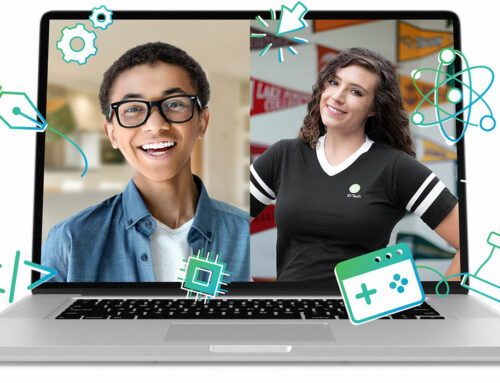
How to Easily Teach Kids Essential Tech Skills
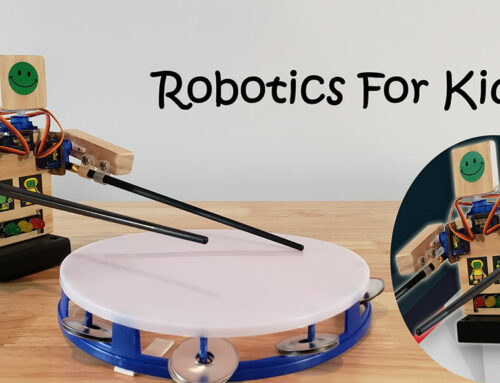
Why Should Homeschoolers Study Robotics?
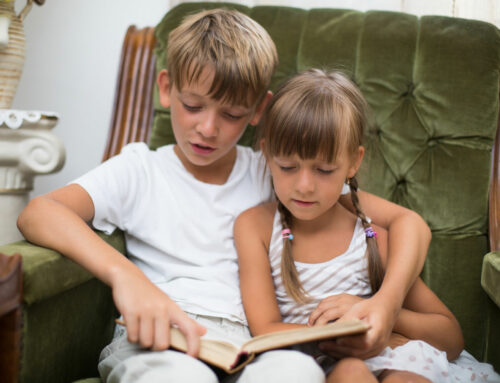
Food for the Mind: The Classical Education
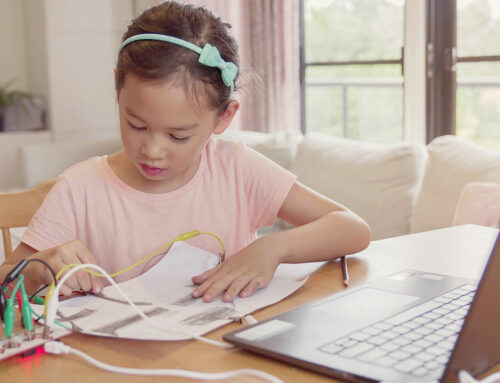
Develop Creativity and STEM Skills By Teaching Coding
Great read!!! Thanks for sharing such a great read, keep sharing such a great blog. Blog like these helps each and every homeschooler in homeschooling their children in the best possible way.
Thank you! We love helping homeschool families find the resources they need! Blessings, Ashley – Customer Relations
No Thank YOU
i need more info
Dear Kimberly,
I am not entirely sure what you need more information about, but if you are trying to find out how to homeschool, check out our website, under Getting Started: https://homeeducator.com/getting-started/
Blessings, Ashley – Customer Relations
I thoroughly enjoyed reading this article! I am hoping and praying that my husband will come to an agreement for me to homeschool our children. Thank you for sharing this!
Dear Michelle,
I am so glad you enjoyed it! We have some other great articles below to help equip you if you decide to homeschool.
Watch: I am a homeschooler (meet other homeschool families)
Record keeping: https://homeeducator.com/keeping-homeschool-records/
Preparing a high school transcript: https://thsc.org/homeschool-transcript/
Great article, I really enjoyed seeing homeschooling from an inside perspective. You mentioned a lot of facts on the homeschooling reasoning. However, I believe that no matter what a parent may choose to do with their child, God will be there guiding them along the way. I plan on becoming a public school teacher myself. And i do believe that God has a strategic plan to place me in a school where I will have an effect on those students like myself (christian and going through public school). I was expecting to read more about the difference between the two. But overall great read, and I appreciate the time and effort put into this article!
Thank you for your kind words! The differences between the two can be subtle or extreme, depending on the state you live in. For instance, in Texas, there are only 3 requirements families must meet, they do not have to report to anyone, and parents should oversee the homeschool, not a program, according to Texas Education Code. However, some states do have rigorous reporting requirements and families must report to the district, or other facilitators, depending on that state’s laws. Learn more about homeschool laws across the United States: https://homeeducator.com/getting-started/state-requirements/
Is Jennings the only author on this source? This page is a little hard to cite and I want to make sure I give credit where credit is due!
Dear Sarah,
Actually, I believe this article was an effort of multiple members of our publications team and our other teams to collect information. Thank you for that. Ms. Jennings one member of our team. The contributors are: Donna Schillinger, Brian D. Ray, Ph.D., Kenzie Knapp, Jeremy Newman
Thank you for sharing this article!
Blessings, Ashley – Customer Support
I’ve been homeschooled all my life and I’m going into 6th grade and I debating if I should stay home school or go to public school and this helped a lot. thank you so much!!!!!!
I love hearing that! Keep up the great work.
Well written and informative. It can be challenging for many parents to transition to homeschool but reading this article answers a lot of questions and concerns.
Thank you! We love helping homeschoolers find great ideas.
Our Services
College Admissions Counseling
UK University Admissions Counseling
EU University Admissions Counseling
College Athletic Recruitment
Crimson Rise: College Prep for Middle Schoolers
Indigo Research: Online Research Opportunities for High Schoolers
Delta Institute: Work Experience Programs For High Schoolers
Graduate School Admissions Counseling
Private Boarding & Day School Admissions
Online Tutoring
Essay Review
Financial Aid & Merit Scholarships
Our Leaders and Counselors
Our Student Success
Crimson Student Alumni
Our Reviews
Our Scholarships
Careers at Crimson
University Profiles
US College Admissions Calculator
GPA Calculator
Practice Standardized Tests
SAT Practice Test
ACT Practice Tests
Personal Essay Topic Generator
eBooks and Infographics
Crimson YouTube Channel
Summer Apply - Best Summer Programs
Top of the Class Podcast
ACCEPTED! Book by Jamie Beaton
Crimson Global Academy
+1 (646) 419-3178
Go back to all articles
Homeschooling vs Traditional Schooling: pros and cons
/f/64062/1015x652/a3c0321afb/screenshot-2022-03-02-115354.png)
As a vast majority of the world went remote in early 2020 at the dawn of the COVID-19 pandemic, students had to quickly adapt to remote learning from home. Due to this, many parents began to consider homeschooling for their child rather than return children to their traditional schooling methods. But what are the pros and cons of homeschooling versus traditional schooling?
Homeschooling: the pros
- No commute: Very often, students can only attend certain public schools if they reside in the right district. Alternatively, if they attend a private school further from home, the commute can be long during peak school run hours. As such, homeschooling saves time which can be spent doing further coursework, exploring personal interests, or spending more time with friends and family.
- Tailor-made Curriculum: Although certain states/countries may have specific requirements on what it takes to graduate from high school if homeschooled, the option does give students and their parents the luxury of exploring personal interests, going at their own pace, and taking advanced courses where the student is able to.
- Custom Schedule: The typical 8am-3pm does not have to hold true with homeschooling! While some legal requirements for a minimum number of hours may be present, students are able to have flexibility to pursue other goals such as competitive gymnastics, travel the world with their families, etc.
- Higher performance: According to ThinkImpact, public school students received an average score of 21 out of 36 on the ACT, whereas homeschooled students received an average of 22.8. As for the SATs, homeschoolers scored a nationwide average of 72 points more than their traditional schooled counterparts in the United States in 2020.
- Safety: The risks of COVID-19, school shootings, and other unfortunate situations are minimized at home. The extent of safety will also vary upon the neighborhood the school and home are located in.
Homeschooling: the cons
- Social life restrictions: Students who are homeschooled do not have classmates with them daily. As such, they can be lonely unless a solid effort is made to interact with peers their age through other activities such as attending a church or place of worship, sports teams, community events, etc.
- Pressure on parent’s time: Working a job and raising a child is already a huge time commitment for most adults. As such, being the child’s teacher is an additional burden on parents which not all are able to undertake. Furthermore, a parent will have to ensure that healthy boundaries are set between the parent and child now that the “teacher and student” dynamic is also present.
- Cost: The cost of a homeschool curriculum can be a few thousand dollars, whereas public school is free. However, it should be noted that homeschool can be cheaper than private school, so it is up to a family to decide how to best use their educational budget here.
Traditional Schooling: the pros
- Social life and development: At school, teens get to spend dozens of hours each week with peers their age, thus giving them a platform to develop their social skills.
- Professional instruction: Teachers at schools are qualified, trained professionals who have mastered their craft and in the later grades specialize in their area of instruction.
- Structure: Many children thrive on having a set routine and structure in their daily schedules, and schools are the greatest source of structure in a youngster’s life.
- Extracurriculars: Schools, especially those with a larger student population, tend to offer extracurriculars which a student is not able to acquire at home. Be it being a part of the chess club, trying out for the football team, or running for student government, certain activities cannot be done in a home setting.
- School spirit: Being a member of a school helps develop a youngster’s identity, and students are able to obtain a sense of belonging (provided the school is a good fit for them, of course!).
- Fostering independence: From keeping track of their own timetable (deadlines, bus schedules, etc), purchasing/bringing their lunch, and finding their way from classes, traditional schooling helps build valuable life skills which shall help students once they graduate.
Traditional Schooling: the cons
- More traditional curriculum: Instead of exploring their own interests, students are forced to study subjects at the same pace as their classmates and course selection is more limited.
- Peer pressure: Be it wearing the latest Nike shoes, fitting in with the cool crowd, or dealing with bullies, peer pressure plays a big part of a teenager’s life and is more present in traditional schooling environments.
- Overwhelmed teachers: Many teachers have dozens of students on their roster and getting each student’s individual needs met is not often accomplished.
- Fitting in: Perhaps the school is simply not a good fit for who your child is – be it the type of curriculum offered, the crowd present, or the overall management of the school.
While these are just a few of the pros and cons seen in traditional schooling vs homeschooling, I would like to remind you that there is no direct answer as to which option is better. A family needs to consider their own needs to make this decision, including their time, teaching capabilities, educational budget, location, future goals, and resources. Here at Crimson we are always happy to discuss these options and also work together to advise a hybrid model if necessary – where students may take some courses outside of school in addition to the courses in their regular schooling. The pandemic has made more families consider homeschooling after seeing how their child has been handling remote learning – but before you jump the gun, make sure to consider all the pros and cons thoroughly!
Your friendly neighbourhood Rise blogger,
Learn more about Crimson Rise’s strategic mentorship, academic support, and extracurricular coaching for young students, and request a free consultation on your child’s journey!
More Articles
"thanos of linkedin" the viral story behind jamie beaton's academic journey (and why it matters).
/f/64062/1000x586/ffdf2ea3bd/jamie-images-banner-mobile.jpg)
How to Write an Effective Brag Sheet for College Applications: Tips from Crimson Experts
/f/64062/992x661/eba1326524/studying-laptop.jpg)
UCAS: What Are The Application Deadlines in 2024?
/f/64062/1920x1080/9a9ca2513c/oxford.png)
- [email protected]
- (650) 338-8226
Cupertino, CA

- Our Philosophy
- Our Results
- News, Media, and Press
- Common Application
- College Application Essay Editing
- Extracurricular Planning
- Academic Guidance
- Summer Programs
- Interview Preparation
Middle School
- Pre-High School Consultation
- Boarding School Admissions
College Admissions
- Academic and Extracurricular Profile Evaluation
- Senior Editor College Application Program
- Summer Program Applications
- Private Consulting Program
- Transfer Admissions
- UC Transfer Admissions
- Ivy League Transfer Admissions
Graduate Admissions
- Graduate School Admissions
- MBA Admissions
Private Tutoring
- SAT/ACT Tutoring
- AP Exam Tutoring
- Olympiad Training
Research Programs
- Science Research Program
- Humanities Competitions
- Passion Project Program
- Ad Hoc Consulting
- Athletic Recruitment
- National Universities Rankings
- Liberal Arts Colleges Rankings
- Public Schools Rankings
Acceptance Rates
- University Acceptance Rates
- Transfer Acceptance Rates
- Supplemental Essays
- College Admissions Data
- Chances Calculator
- GPA Calculator
National Universities
- College Acceptance Rates
- College Overall Acceptance Rates
- College Regular Acceptance Rates
- College Early Acceptance Rates
- Ivy League Acceptance Rates
- Ivy League Overall Acceptance Rates
- Ivy League Regular Acceptance Rates
- Ivy League Early Acceptance Rates
Public Schools
- Public Schools Acceptance Rates
- Public Schools Overall Acceptance Rates
- Public Schools Regular Acceptance Rates
- Public Schools Early Acceptance Rates
Liberal Arts
- Liberal Arts Colleges Acceptance Rates
- Liberal Arts Colleges Overall Acceptance Rates
- Liberal Arts Colleges Regular Acceptance Rates
- Liberal Arts Colleges Early Acceptance Rates

Public Schools vs Homeschooling: Which Is Better?

By Eric Eng

In today’s rapidly changing society, the necessity for a quality education that equips our children to face the challenges of the future confidently can’t be overstated. It’s crucial to find the right learning environment for your child, a place where they can flourish both academically and socially.
The traditional institution of public schools and the more flexible solution of homeschooling are both viable options in this regard. Which one, though, is a better fit for your child? This article offers an in-depth comparison of public schools vs homeschooling, aiming to provide you with a comprehensive analysis of the two educational approaches.
Understanding Public Schools
Public schools are the cultural norm for child education in many regions of the world and have a structured system. These institutions function under a system that is often regulated by local and federal government bodies. Let’s examine the structure of public education and what it entails for the students.

When we delve into the structure of public education, we find a fascinating web of interconnected elements that shape the learning experience for students. Public schools follow a standardized curriculum designed to accommodate all students, irrespective of their individual skills or future prospects. This approach ensures that every child has access to a well-rounded education that prepares them for the challenges of the future.
Usually, the curriculum is divided into core subjects, such as Maths, Science, and English, along with optional electives based on the grade of the student. This diverse range of subjects allows students to explore their interests and develop a broad knowledge base. From learning about the laws of physics to analyzing the works of Shakespeare, public schools provide a rich tapestry of academic opportunities.
Assessments and exams are also regularly conducted to measure a student’s progress and understanding of the material. These evaluations can often be high-stakes, affecting a student’s future opportunities for higher education. However, they also serve as a valuable tool for self-reflection and growth, allowing students to identify areas for improvement and celebrate their achievements.
Benefits of Public Schooling
Public schools serve as a melting pot of diverse cultures, races, and socio-economic backgrounds, thereby fostering social development among students. In the hallways and classrooms of these institutions, students learn to communicate, collaborate, and interact with a multitude of peers, promoting a broader perspective on life. The friendships formed in public schools often transcend boundaries, creating lifelong bonds that celebrate the beauty of diversity.
Additionally, many schools offer resources such as a variety of clubs , extracurricular activities, and opportunities for community involvement that can enhance a child’s overall development.
From joining a robotics club to participating in a school play, these extracurricular activities provide students a platform to explore their passions, develop new skills, and build a sense of belonging. This aspect becomes particularly significant when considering the advantages of public schools vs homeschooling.
Public schools also offer a structured and standardized curriculum. They provide students with the chance to measure their skills against a recognized standard and potentially prepare them for university and employment applications. The clear guidelines and expectations set by the curriculum enable students to set goals, track their progress, and strive for excellence.
Challenges in Public Schools
Public schools , however, are not without their issues. One of the most significant disadvantages is the high student-to-teacher ratio, which often reduces the individual attention a child receives. In a classroom filled with eager minds, it can be challenging for teachers to provide personalized guidance to every student.
Efforts are being made to address this issue, with innovative teaching methods and support systems being implemented to ensure that every child receives the attention they deserve.

Furthermore, the uniform curriculum might not cater to every student’s learning style or pace. Each child is unique, with their own strengths and weaknesses. Some may excel in mathematics while struggling with language arts, while others may thrive in creative pursuits but find science challenging.
Recognizing and accommodating these differences is a constant challenge for public schools as they strive to provide an inclusive and supportive learning environment for all.
Bullying, peer pressure, and other social issues are also prevalent in public school settings, which can affect a child’s mental health and overall well-being. According to several studies, these problems can negatively influence an adolescent’s academic and personal growth.
Schools are working tirelessly to create safe and nurturing environments, implementing anti-bullying programs, fostering a culture of empathy and respect, and providing counseling services to support students through their emotional journeys.
As we explore the world of public schools, it becomes evident that these institutions are more than just buildings filled with classrooms. They are vibrant communities where children learn, grow, and discover their potential. While challenges exist, the dedication and passion of educators, parents, and students continue to shape public education and pave the way for a brighter future.
Unpacking Homeschooling
Homeschooling, which involves teaching children at home, usually by parents or tutors, is steadily gaining popularity worldwide. So, let’s unpack homeschooling and explore how it functions, its benefits, and potential drawbacks.
Homeschooling is not a new concept; in fact, it has been practiced for centuries. Before the establishment of formal schooling systems, parents were the primary educators of their children. Today, homeschooling has evolved into a well-structured and organized educational approach that provides numerous advantages for both parents and students.
The Homeschooling Approach
Homeschooling undertakes a precise, flexible, and personalized approach to learning. The curriculum can be tailored to suit a child’s individual needs, learning style, and pace of learning. Given its one-on-one nature, homeschooling ensures the child gets their tutor’s full attention during their learning sessions.

Unlike traditional classrooms, homeschooling allows for a more hands-on and experiential learning experience. Students have the freedom to explore their interests in-depth, conduct experiments, and engage in real-life applications of the subjects they are studying. This approach fosters a love for learning and encourages critical thinking skills.
The assessment methods in homeschooling are usually project-based or portfolio-based, focusing less on grades and more on a child’s comprehension of the material. This approach allows students to showcase their understanding through creative projects, presentations, and practical demonstrations, which sets it apart in the public schools vs homeschooling discussion.
Advantages of Homeschooling
The most significant advantage of homeschooling is the provision of a highly customized academic approach. It enables children to learn at their own pace, delve deeper into their interests, and bypass formalities that might not be necessarily enriching. This flexibility allows students to excel in areas they are passionate about and spend more time on challenging subjects.
Furthermore, homeschooling facilitates a strong bond between the child and parent, nurturing an environment of trust and mutual respect. The close relationship between the student and their primary educator fosters open communication, personalized guidance, and a deep understanding of the child’s strengths and weaknesses.
Additional benefits include the ability to avoid negative school environments, such as bullying and peer pressure. Homeschooled students can focus on their studies without distractions and develop a positive self-image. Moreover, homeschooling offers flexibility in shaping the child’s schedule. Students can pursue extracurricular activities, hobbies, and community service without compromising their education.
Potential Drawbacks of Homeschooling
However, homeschooling comes with its set of challenges. The most apparent disadvantage is the social development aspect. The absence of daily interaction with a diverse group of students – a natural environment for social skill development – may not be readily available.
To counter this, homeschooling families often participate in co-op programs, sports teams, and community activities to provide socialization opportunities for their children.
Another significant drawback includes parental demands; as parents are responsible for educating their children, they must make a substantial time commitment that is not always feasible due to full-time jobs, other children, household duties, and so on. Despite the challenges, many parents find creative ways to balance their responsibilities and provide a quality education for their children.
Additionally, the parent must also be capable of teaching the complete curriculum, which can be daunting. However, with the abundance of educational resources available today, including online courses, textbooks, and educational software, parents can access the necessary tools to support their teaching efforts and ensure a well-rounded education for their children.
Key Differences: Public Schools vs Homeschooling
Having immersed ourselves in the basics of both methods, let’s now focus on some of the primary differences.
Curriculum Comparison
When it comes to curriculum, public schools offer a structured and standardized approach. They follow a set curriculum that is designed to cater to all students equally. This ensures that all students receive the same level of education and have access to the same resources and opportunities.

On the other hand, homeschooling provides a tailored curriculum that is specifically designed to cater to individual learning styles, interests, and speeds. Homeschooling parents have the flexibility to choose and create their own curriculum, allowing them to customize their child’s education. This personalized approach can be beneficial for students who have unique learning needs or who excel in certain subjects.
For example, if a child is particularly interested in science, homeschooling allows them to delve deeper into the subject and explore advanced concepts at an earlier age. Similarly, if a child is struggling with a particular subject, homeschooling allows for more focused attention and additional support to help them overcome their challenges.
Socialization Differences
One of the main concerns often raised about homeschooling is the lack of socialization opportunities. Public schools provide a plethora of opportunities for social interactions among peers, which is essential for social growth and development.
However, it is important to note that homeschooling does not mean complete isolation. There are various ways in which homeschooled children can socialize and interact with others. Homeschooling communities often organize group activities, field trips, and co-op classes where children can meet and socialize with other homeschoolers. Additionally, extracurricular activities such as sports, music lessons, and art classes can also provide opportunities for socialization.
Moreover, homeschooling allows children to interact with people of different ages and backgrounds, as they are not limited to interacting only with their peers. This can foster a more diverse and inclusive social environment where children learn to communicate and interact with people of all ages, including adults.
Flexibility and Personalization
Public schools operate on a strict schedule, with set timings for classes, breaks, and other activities. This structure can be beneficial for some students, as it teaches them discipline and time management skills. However, it can also be limiting for those who thrive in a more flexible learning environment.
Homeschooling offers flexibility in terms of study timings and methods. Parents can choose the best time of day for their child to study, taking into consideration their individual preferences and energy levels. This flexibility allows children to learn at their own pace and in a way that suits their learning style.
Moreover, personalization is inherent in homeschooling. With one-on-one instruction, homeschooling parents can tailor their teaching methods to match their child’s unique learning needs. They can adapt the curriculum, use different teaching techniques, and provide additional support or challenges as needed. This personalized approach can lead to a deeper understanding of the material and a more enjoyable learning experience.
In contrast, public schools have a more rigid structure, with a standardized curriculum and teaching methods that may not cater to the individual needs and preferences of every student. While this approach ensures consistency and equal access to education, it may not be the best fit for every child.
Factors to Consider: Public Schools vs Homeschooling
When deciding the best education method for your child, it’s crucial to consider several factors.

Assessing Your Child’s Needs
Firstly, a child’s needs, learning style, and abilities are vital factors. If they are quick learners, display self-motivation, or have specific academic interests, homeschooling might be an excellent choice. On the other hand, if your child thrives in a structured environment with a competitive spirit, public schools may be the better option.
Evaluating Your Family’s Lifestyle
Your family’s lifestyle and commitments are also crucial deciding factors. Remember, homeschooling requires a substantial commitment of time and effort from parents. If your family can’t invest the necessary time and energy or if you value the convenience of a public school’s structured timings, public schools may be best.
Considering Long-Term Implications
Lastly, think about the long-term implications of your choice. Public schools provide a recognized diploma, which can be advantageous for university applications or certain jobs. Homeschooling, while offering flexibility, may require more effort to prove the quality of education for similar applications.
To sum up, both public schools and homeschooling have their strengths and weaknesses. The choosing factor, ultimately, depends on your child’s needs, your family’s resources, and your long-term educational goals for your child.
Having all the necessary information is important before choosing any course of action. AdmissionSight is always here to assist you with any questions or concerns. We have more than ten years of expertise assisting students in successfully navigating the challenging admissions process.
Consult with AdmissionSight and find out what we can do to help you get into the school of your choice by ensuring that you are sufficiently aware and well-prepared for the application process.
Want to assess your chances of admission? Take our FREE chances calculator today!

Why College Admissions Isn’t Perfect

US News Rankings

The Personal Statement: The Holy Grail of College Admissions

The Modern Day 4.0 and 1600 SAT Score Student Is No Longer Impressive

The Competitive Nature of College Admissions for Asian Americans

The College Application

Our Comprehensive Approach

Ivy League Schools

How Early Should You Prepare for College?

Featured in US News & World Report Best Colleges Publication

Congratulations to AdmissionSight Students and their Acceptances!

College Rejection

College Rankings

College Consultants Could Make A Difference


College Admissions Scandal and Higher Education

How to Qualify for National Merit Semifinalist 2025

How to Update Yale After Submitting Your Application

What Are the Score Choice Policies at Top 50 Universities?

How to Apply to LaunchX

How to Submit Supplemental Materials to Colleges

How to Apply for BS/DO Programs

How to Update Cornell After Submitting Your Application

How to Update Columbia After Submitting Your Application

How to Update Harvard After Submitting Your Application

What Should You Write in Your MIT FUN Form?

How to Secure an Internal Transfer and Dual Degree to Wharton

100 Research Topics for High School Students

SAT Test Dates and Deadlines for 2024-2025

How to Join the FBLA Competitive Events

How to Apply for the Coolidge Scholarship

Top 33 Colleges That Require Test Scores

How to Apply for RISE by Schmidt Futures and the Rhodes Trust
Leave a comment cancel reply.
Your email address will not be published. Required fields are marked *
Save my name, email, and website in this browser for the next time I comment.
Recent Articles

How to Qualify for National...

How to Update Yale After...

What Are the Score Choice...

How to Submit Supplemental Materials...

How to Apply for BS/DO...

How to Update Cornell After...

How to Update Columbia After...

How to Update Harvard After...

What Should You Write in...

How to Secure an Internal...

100 Research Topics for High...
Sign up now to receive insights on how to navigate the college admissions process..

Admissions Counseling
- Academic & Extracurricular Profile Evaluation
Copyright © AdmissionSight 2024
Privacy Policy - Terms and Conditions

Homeschool vs. Public School (Updated for 2024)
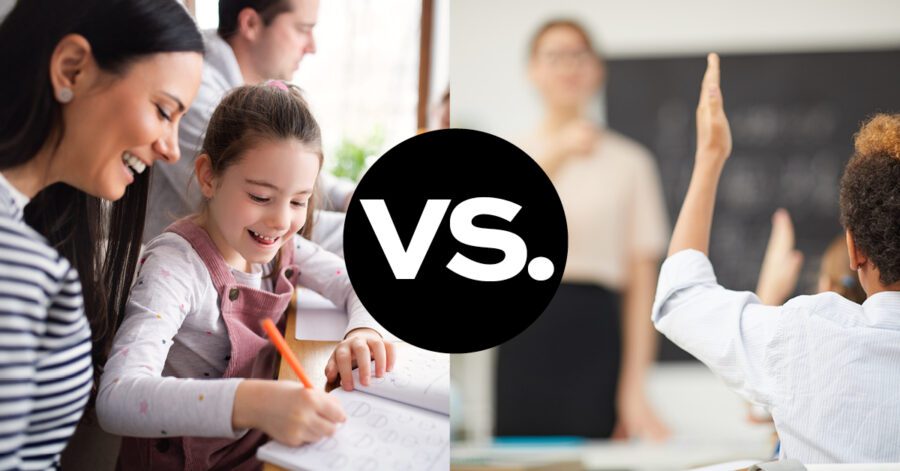
At some point, you’ve probably heard the question asked (or maybe you’ve asked the question): why homeschool when your child can go to a public school funded by the government?
But perhaps we should flip that question around. Homeschooling has grown in popularity with families throughout the United States. Several studies suggest that between 5 and 6 percent of school-age children are homeschooled (that’s about three million kids), and this number increases year by year. During the COVID-19 pandemic, many parents found themselves homeschooling either outright or de facto —and that hands-on experience only increased the popularity of homeschooling!
Why is homeschooling more attractive than public schools and traditional schooling to these parents?
Why Homeschool?
There are more reasons to homeschool than ever, but here are five reasons in particular why parents are choosing to homeschool their children in increasing numbers.
1. Religious Freedom
Religious freedom is one of the most repeated answers offered by parents when making the decision to homeschool their child. Public schools don’t incorporate religious studies into the classroom. Public school curricula may teach a different set of values and beliefs than what parents believe and want to instill in their child.
Homeschooling, on the other hand, affords parents the opportunity to incorporate Bible studies, prayers, and values throughout the lesson plan.
Interested in homeschooling freedom? Bookmark the Homeschool Freedom Action Center .
2. Academic Excellence
Parents also often choose to homeschool because public education severely underwhelms them. These parents pursue homeschooling as a means to academic excellence .
Homeschools by definition have better teacher-to-student ratios than public schools, which means that homeschooled students benefit from one-on-one attention. Also, in a home school, the parents control the curriculum, which means parents can ensure the content is worthwhile.
3. Safety and Security
Concern over a child’s safety is another reason why so many parents choose to homeschool. Some children are subjected to negative influences such as bullying, unhealthy social dynamics, and the presence of drugs and alcohol in public schools.
However, in a homeschool environment, parents are able to watch over their child and help them develop without those stressors and dangers.
4. Personalized Learning
In a homeschool setting, parents are able to offer more personalized learning for their child. Public school teachers have a classroom of students with different abilities and levels of learning. The lesson plans won’t be tailored for each individual student.
Homeschool allows for the parents to assess their child’s strengths and weaknesses and help build lessons around their needs. This type of teaching provides flexibility to give the child what they need to learn and skip ahead if they grasp the subject.
5. Family Time
Homeschooling is a family effort. There is collaboration between siblings and parents to come together and share knowledge and experiences. This level of connectedness goes beyond what can be provided in public schools.
The opportunity to reinforce family values and beliefs while developing a stronger sense of self is why many families choose homeschooling over public schooling.
Want more reasons to homeschool? Read: “ The Benefits of Homeschooling: A Graduate’s Perspective ”
Why Not Public School?
These are a few reasons why homeschool parents often decide to homeschool their children rather than send them to public school. Here are four such reasons:
1. Lower Academic Outcomes
Studies have revealed that homeschool students typically score higher than public school students on standardized tests. Parents’ level of education do not change the student’s success. 1 https://www.nheri.org/academic-achievement-homeschool-students/
Homeschool students also typically do better in college. Homeschool students have a higher rate of graduating college than students who attended public school. One study revealed that homeschooled students graduated with an average GPA of 3.46 while their public school peers graduated with an average of 3.16. The same study also showed that homeschooled students graduated from college at a higher rate (66.7%) than their peers (57.5%). 2 https://www.nheri.org/research-facts-on-homeschooling/ 3 https://www.cbsnews.com/news/can-homeschoolers-do-well-in-college/
2. Poorer Social Environments
Contrary to the popular misconception, homeschool students are often better socialized than their public school counterparts. They are more likely to participate in political drives, sports teams, church ministries, and community work. 4 https://www.tandfonline.com/doi/full/10.1080/15582159.2017.1395638
Public schools, meanwhile, often present challenges for social development, such as bullying, discouragement, and negative peer influences. For example, according to one study, 5% of students between the ages of twelve and eighteen reported that they had been afraid of attack or harm at school in 2019. 5 https://nces.ed.gov/fastfacts/display.asp?id=49
That’s 1 out of 20 students, and the average class size in the USA is 20.3. 6 https://nces.ed.gov/surveys/ntps/tables/ntps1718_fltable06_t1s.asp
3. Lack of Individualized Attention
Public schools often have large class sizes (in fact, the average elementary class size is 21.1, and the average secondary school class size is 26.8) 7 https://www.oecd.org/education/school/talis-excel-figures-and-tables.htm , making it challenging for teachers to provide individualized attention to each student. In particular, students with specific learning needs may not get the support they require.
4. One-Size-Fits-All Approach
Public education adopts a “one-size-fits-all” approach. The curriculum is standardized and advances forward with no regard to the student’s development, following fixed schedules and often either ignoring specific learning needs or creating new problems and further inflexibilities with Individualized Education Plans.
The evidence is abundant and the collective experience of homeschoolers shows that homeschooling works . Public schools, on the other hand, afford poorer outcomes all around.
Why send your child to public school when you can homeschool?
Written by:
Classical conversations, i want to start homeschooling.
A Classical Conversations team member will contact you shortly to help you learn more about enriching your child’s classical, Christian homeschool education.
- Pioneering Classical Christian Education in Colombia
- For Dads: 20 Ways to Support Your Wife in Your Home School
- Discover New Opportunities for Growth in the Classical Learning Cohort
- Happy Father’s Day, Men!
- E-books vs Physical Books: The Great Debate
- Classical Christian Education
- Classical Conversations Programs
- Encouragement
- Homeschooling
- Impact Your Community
- International Spotlight
Join the Conversation
Community is at our core, with families doing life together as they learn.
Related Posts - Featured

The Desert Island Game: Leigh Bortins’ Top 5 Books
I have been asked to share the 5 titles I’d bring on a deserted island....

The Best Books of All Time (According to These Classical Conversations Leaders)
Have you ever wondered what the people behind Classical Conversations read? Classical Conversations is a...

Your Guide to the Challenge Program
Are you intrigued by the idea of a rigorous, classical, Christ-centered, and community-based homeschool program...
What can we help you find?
- Skip to primary navigation
- Skip to main content
- Skip to footer
BJU Press Blog
Homeschool vs. Public School vs. Private School: Which is best?
March 8, 2022 by Guest Writer
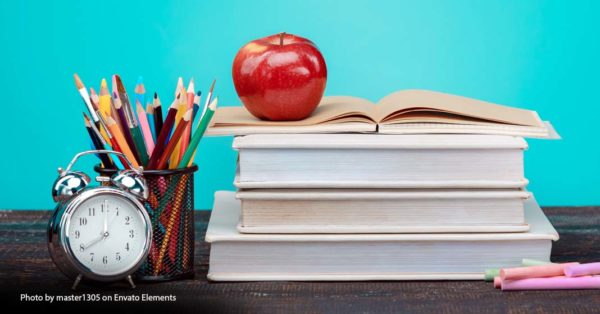
Choosing a path for your children’s education is a big deal, especially when choosing between homeschool vs. public school vs. private school. You’re going to face questions like “should I homeschool,” “is homeschooling better than public school,” or “is private schooling better than public or homeschooling?” In addition to which option is most effective or best for each child, you’ll also be wondering about the cost of each education option. Which is the best choice? That may depend on your family, needs, and the decisions you come to personally after prayer and consideration. Here are the differences, pros, cons, and costs of each schooling option. We have also included tips on how to make your decision for your children’s education.
Homeschool vs. Public School
You’re going to see the largest number of differences between homeschool or public school. While the public-school movement and state mandated education has lead many positive changes in America and other nations, homeschooling also has its unique opportunities, challenges, and benefits that a public school can’t account for. If you’re asking whether homeschooling is better than public school, that may be a question you need to decide on a case-by-case basis.
What are the differences?
- Personalized education. Parents choose their child’s curriculum and personally oversee their education.
- Flexible time management. Families can schedule school to fit their time needs and preferences.
- One-on-one teaching. Parents can devote the time and attention their child needs to learn.
- School at home. Children are at home with their parents during school hours instead of in a classroom.
Public School
- Comprehensive curriculum. Every public school is required to teach a district-wide or statewide curriculum to all students in all grades.
- Taught by trained professionals. Teachers must be state certified and have a bachelor’s degree. They must also undergo background checks.
- Group learning. Children are with at least 20 other students in a class and are all taught at the same time.
- More resources available. Public schools offer extra programs such as sports, theatre, debate, and other clubs.
- Flexibility . Both parents may work outside the home if needed or wanted.
Public School at Home (Virtual School)
- Home learning from trained professionals. Children are at home but are under the instruction of trained professionals.
- Statewide or district-wide curriculum. Children learn from a statewide or district-wide curriculum. They access classes online instead of in an actual classroom.
- Limited in-person exposure to other students. Children don’t generally interact with fellow classmates.
- Operates during regular school hours. Your child must participate in and finish their work within a certain time frame during the day.
Cost of Homeschooling Vs. Public School
Homeschooling is more expensive than public school, especially depending on which curriculum you use. Public school, by law, is free to everyone.
Cost of Homeschooling
Homeschooling can cost anywhere from a couple hundred to nearly $1,000 a year depending on the curriculum. They will also need to pay for additional resources and supplies, but these costs can be greatly reduced because you only need to purchase what your students may need or use. Additionally, many free resources are available, including free printable downloads. Parents can also save money by purchasing curriculum from other homeschool parents or at homeschool conventions.
Cost of Public School
Public school is free. But you do have to pay for school supplies. And those costs are significantly higher than they were even a year ago. In fact, families will pay an average of $577 on supplies for elementary students this year. Those with middle school students should expect to spend an average of $763. Parents of high school students should plan on paying around $1,223 on supplies.
Families are also required to pay mandatory school fees, which include textbook fees and use of technology. These mandatory fees range between $20 to $40 per student but can be much higher. For example, some schools charge as much as $300 for a required Chromebook that students must purchase, even if they already have their own tablet or laptop. Schools can also charge additional fees for things such as textbooks and a yearbook.
Extracurricular activities don’t come cheap, either. Some public schools charge as much as $400 per year for student athletic programs.
Homeschool vs. Private School
When choosing between homeschool or private school, private schooling options can often give you the same options as a traditional school environment with fewer drawbacks that you might see in a public-school environment. You can choose a Christian school that more closely aligns with your family goals, or a private school that focuses heavily on academics. You ensure that trained professionals are teaching your children and can be confident that you agree with the curriculum they’re teaching.
- Smaller class sizes. Private Christian schools tend to have smaller class sizes than public schools.
- Peer-to-peer relationships. Despite smaller class sizes, your children will still be able to develop and build relationships with their peers and teachers.
- Curriculum provided. Many private schools include the cost of textbooks and other required materials in tuition costs.
- Faith-based or academic focused. Christian schools and other private schools have the freedom to change their curriculum and programs to align with a biblical worldview or more specific learning goals.
- Tuition. Private schools include tuition costs that may be significant, especially for single-income households.
Cost of Homeschooling Vs. Private School
Although private school can cost thousands of dollars—much more than homeschooling—there are several private school scholarships available. There are also a small number of free private schools. Boarding schools provide a good financial alternative.
The average annual cost of a private school in the US is $12,350 for K-12. For a private high school, the average annual cost is $16,040.
Homeschooling Vs. Traditional School Learning
Undoubtedly, there are differences in learning between homeschooling and traditional schooling.
Homeschool Learning
In a homeschool environment, every child receives personal, one-on-one instruction from either you or another teacher online or on DVD. Since you control your child’s schedule, you can decide at what pace to keep your child’s schooling. For instance, if your child breezes through math but takes longer to grasp reading, you may adjust his daily schedule to accommodate his needs. You also can choose the time frame to fit your required 180 days of school. For example, you may decide to take a shorter Christmas break and no spring break so you can finish before traditional schools for summer vacation.
Additionally, you can plan how much of the curriculum you complete in the year. If you think your child can finish some if not all his courses by the end of the school year, you have a good chance of accomplishing your goal. One of the biggest differences in homeschooling is that your child can work at his own pace and take extra time with certain subjects if needed.
Traditional School Learning
In a traditional school setting, whether public or private school, your child learns from trained professionals in a classroom setting. Class sizes can range between 10–30 students. Teachers in smaller classrooms may be able to offer personalized guidance for students, but larger classroom sizes can make this difficult.
Teachers in state-run or private schools must meet state standards, so their curriculum and lesson plans will often be fixed according to set guidelines. Private schools may have more flexibility while public schools will more closely follow these guidelines. Students will also take time to prepare for and take achievement tests, which are often required for accreditation.
Comparing the Pros and Cons of Schooling Options
As you make plans for your children’s futures, you’re going to need to compare the pros and cons of the schooling options available to you. Compare and contrast the benefits and disadvantages of homeschooling, public schooling, and private schooling.
Benefits of Homeschooling
- Parents have control over the child’s curriculum and educational goals.
- Parents choose the cost and complexity of curriculum and materials. You also get to control exactly what your child is learning and can ensure that their curriculum is taught from a biblical worldview.
- Children are at home with one or both parents all day. This allows you to give your child the spiritual, emotional, and academic support he needs.
- Parents enjoy flexibility to manage the school schedule.
- Your children are safer in your care. You have greater influence over the friendships they form. There are also more opportunities for interacting with adults.
- Testing is optional.
Disadvantages of Homeschooling
- Requires a substantial commitment of time and effort by parents. This is especially important to consider if you have more than one child.
- Education may not be well-rounded if parents avoid subjects such as higher science, math, and foreign languages.
- Parents who lack time management and organization skills will struggle to fulfill their educational responsibilities.
- Families may have a harder time finding socialization opportunities for their children, particularly in less populated areas without a nearby homeschool group, or if financial limitations prevent participation in extracurricular activities.
Benefits of Public School
- Your child’s care and education are overseen by trained professionals.
- Your child has many opportunities to interact and socialize with other children.
- Larger classroom sizes can encourage students to compete academically and motivate them to work harder.
- More extracurricular activities are available. Your child will have plenty of opportunities to get involved in sports or other clubs that interest them.
Disadvantages of Public School
- Your child may be negatively influenced by other children and are limited in their opportunities to connect with adults.
- Students don’t have the opportunity to learn at their own pace. Some may struggle to understand the material and fall behind while the rest of the class moves on.
- Children learn a secular curriculum that lacks a biblical foundation.
- A fixed, state curriculum may not offer the flexibility and learning opportunities your child needs.
- You may find it more difficult to develop full relationships with your children when they are away for 7–8 hours per day, five days a week.
Benefits of Private School
- High academic focus. Private schools motivate students to push themselves academically and achieve greater success.
- Networking. Private schools have community connections that can help your child pursue the college, internship, or career of their dreams.
- Superior technology. Students may have access to much better computers and other technologies.
- Biblical worldview. Christian private schools can offer a biblical worldview just as you would choose for your child in a homeschool setting.
- Smaller class sizes. Private schools generally keep class sizes to 10 or fewer students. This gives teachers greater opportunities for one-on-one time with pupils.
Disadvantages of Private School
- Expensive. Be prepared to invest as much as $12,000 to $16,000 for your child’s education.
- Not as many extracurricular activities. Private schools don’t offer as wide a range of sports or clubs as public schools.
- Greater pressure. Students face a considerable amount of pressure to succeed in a private school. High academic standards and expectations can result in anxiety and stress for some students.
- Limited availability. There may not be a suitable private school with open enrollment in your area.
How to Choose Between Homeschool, Public School, and Private School
To choose between homeschool, public school, and private school, you’ll need to consider all the information about each schooling option. Narrow it down to the two you believe would work best for your family. Seek guidance from God’s Word and apply biblical principles in making your decision. Some good questions to ask are, “Which choice would most glorify God?” “Which one would be the most spiritually beneficial for our family?” “Which one best meets our family’s specific needs and goals?” If you know people who have school age children in one or all these schooling options, ask for their opinion and advice. Spend time praying together as a family. Ask that the Lord will bring you and your spouse to the same decision.
Should You Homeschool?
Homeschooling is a personal decision that requires much consideration and prayer. Just because homeschooling works for one family doesn’t necessarily mean it will work for another. It is a huge family and time commitment. As your child’s educator, you are responsible for choosing the curriculum, planning the school calendar, keeping up with daily assignments, and grading your child’s work. You are also legally responsible for your child’s education and making sure they are meeting state requirements. However, homeschooling is also very rewarding.
We at BJU Press believe homeschooling is a valuable and truly wonderful option for your child’s education. No one else knows your child as well as you; therefore, you understand your child’s educational strengths, limitations, interests, and capabilities better than anyone else. But homeschooling may not be right for your family, and that’s okay.
Whichever option you choose, ensure that you make your decision in the light of God’s word and go into your choice confident that you are pursuing His will for your children.
About Guest Writer
This post was written by a guest writer for BJU Press. Learn more about the guest writer in the description above. If you have any questions regarding this post, please direct them to [email protected] .
Reader Interactions
June 30, 2022 at 8:45 pm
I like your homeschool tips. I need to get my kid into a private school. I’ll have to do my research to make sure I choose the right one.
Leave a Reply
Your email address will not be published. Required fields are marked *
Save my name, email, and website in this browser for the next time I comment.
- About BJU Press
- Conversation Guidelines
- Terms of Use & Copyright
24/7 writing help on your phone
To install StudyMoose App tap and then “Add to Home Screen”
Homeschool vs Public Schools
Save to my list
Remove from my list

Homeschool vs Public Schools. (2016, Oct 03). Retrieved from https://studymoose.com/homeschool-vs-public-schools-essay
"Homeschool vs Public Schools." StudyMoose , 3 Oct 2016, https://studymoose.com/homeschool-vs-public-schools-essay
StudyMoose. (2016). Homeschool vs Public Schools . [Online]. Available at: https://studymoose.com/homeschool-vs-public-schools-essay [Accessed: 29 Jun. 2024]
"Homeschool vs Public Schools." StudyMoose, Oct 03, 2016. Accessed June 29, 2024. https://studymoose.com/homeschool-vs-public-schools-essay
"Homeschool vs Public Schools," StudyMoose , 03-Oct-2016. [Online]. Available: https://studymoose.com/homeschool-vs-public-schools-essay. [Accessed: 29-Jun-2024]
StudyMoose. (2016). Homeschool vs Public Schools . [Online]. Available at: https://studymoose.com/homeschool-vs-public-schools-essay [Accessed: 29-Jun-2024]
- The State of Education in Malaysia: Homeschool Over Public School Pages: 3 (806 words)
- Public Schools vs Private Schools: Pros & Cons Research Pages: 8 (2371 words)
- Public Schools vs. Private Schools Pages: 2 (443 words)
- Private Schools vs Public Schools Pages: 1 (297 words)
- Single Sex schools and Mixed Schools Pages: 2 (566 words)
- Promoting national unity in Malaysian public schools Pages: 12 (3473 words)
- Should Creationism Be Taught in Public Schools? Pages: 8 (2133 words)
- Damaged Facilities in Public Schools Pages: 10 (2984 words)
- Does Segregation of Children in Public Schools Solely on the Basis of Race Pages: 11 (3164 words)
- Issue Of Literacy And Studying English In Bangladesh Public Schools Pages: 7 (1965 words)
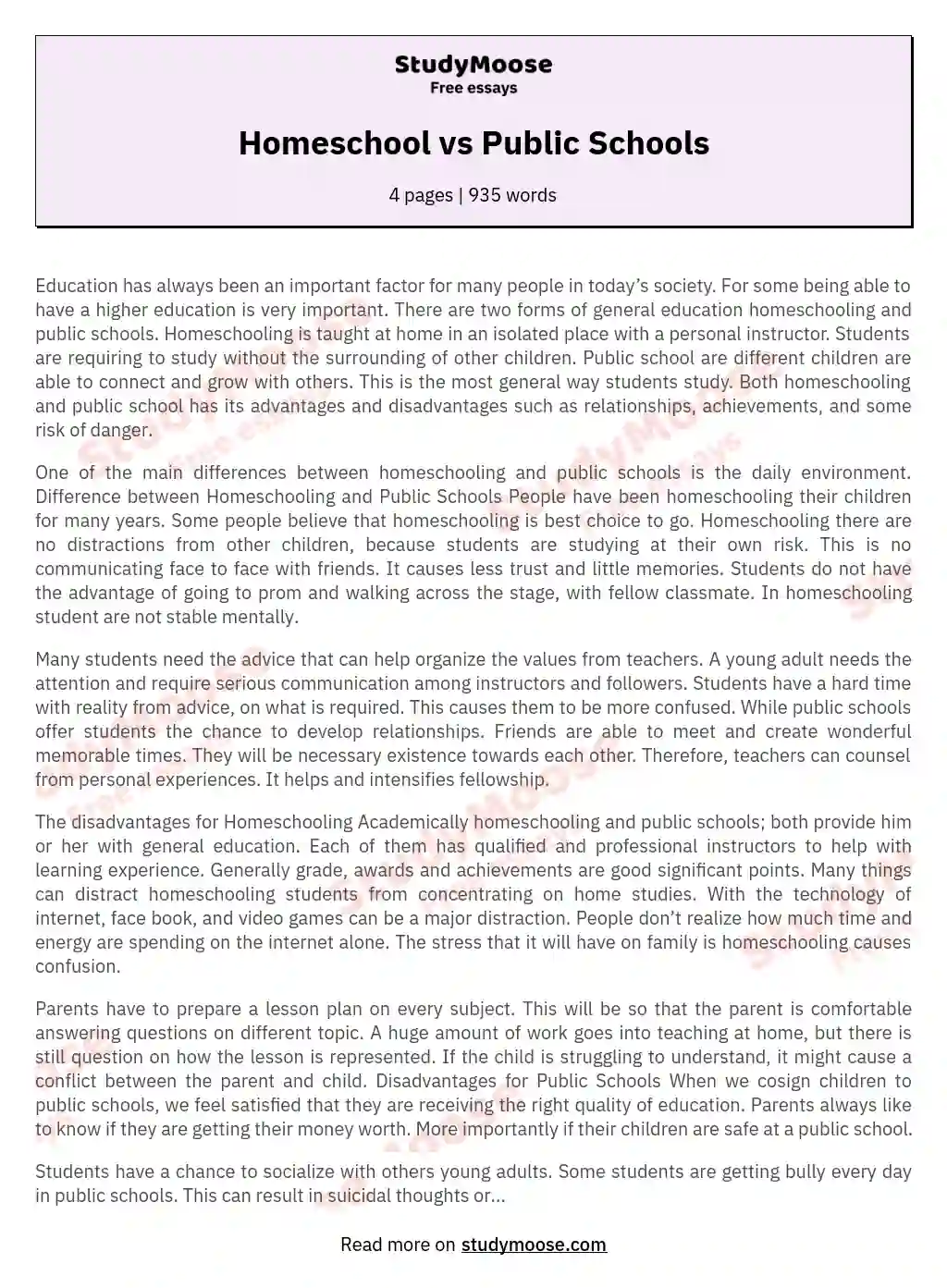
👋 Hi! I’m your smart assistant Amy!
Don’t know where to start? Type your requirements and I’ll connect you to an academic expert within 3 minutes.
| / ✓ % width | Posts: |
compare and contrast essay about home school and public school - major topic
ada 1 / 1 Aug 6, 2010 #1 hi everyone if i want to write compare and contrast essay about home school and public school what are the major topic to talk about?
nanncy22 - / 3 Aug 6, 2010 #2 homescholling; 1. school fees (more expensive) 2. can not socialize well (no experience of interaction / social competition) 3. Curriculum materials can be adjusted to the child's ability level Good Luck
OP ada 1 / 1 Aug 6, 2010 #3 thank u sooo much what about if i want to write cause and effect essay about single sex schools can improve education what are the major topics to talk about???
freezard7734 17 / 209 Aug 6, 2010 #4 homescholling; 1. school fees (more expensive) 2. can not socialize well (no experience of interaction / social competition) 3. Curriculum materials can be adjusted to the child's ability level Good Luck Well... I object to the school expense one because, technically, public schools are free... so the expenses should not be significantly different from that of home school. I would actually think that home school is more expensive because you will have to purchase or rent textbooks and materials through local schools. Another topic I might add is how there is limited materials/classes available at school while at home, you can even learn classes and materials that are not offered at school. At my school, for instance, the only AP's offered are: Chem, Physics, Calculus, English Literature, Biology, and Psychology. Others, we have to learn on our own. And, by the way, please make your subject more specific and helpful. Right now, your thread is in danger of being deleted by the moderators. Just a heads up :]
himaya 3 / 7 Aug 6, 2010 #5 Single Sex school: Improve concentration level Take specific classes for different gender. Like girls can have cook class :)
nanncy22 - / 3 Aug 7, 2010 #6 that's great idea =)

| / / |
Argumentative About Homeschooling
- Categories: Homeschooling
About this sample

Words: 704 |
Published: Mar 19, 2024
Words: 704 | Pages: 2 | 4 min read
Table of contents
Tailoring education to individual needs, flexible schedule for experiential learning, a nurturing and supportive environment, socialization and social skills, academic rigor and accountability, mitigating drawbacks and finding solutions.

Cite this Essay
Let us write you an essay from scratch
- 450+ experts on 30 subjects ready to help
- Custom essay delivered in as few as 3 hours
Get high-quality help

Verified writer
- Expert in: Education

+ 120 experts online
By clicking “Check Writers’ Offers”, you agree to our terms of service and privacy policy . We’ll occasionally send you promo and account related email
No need to pay just yet!
Related Essays
1 pages / 662 words
3 pages / 1318 words
3 pages / 1532 words
1 pages / 609 words
Remember! This is just a sample.
You can get your custom paper by one of our expert writers.
121 writers online
Still can’t find what you need?
Browse our vast selection of original essay samples, each expertly formatted and styled
Related Essays on Homeschooling
Education is one of the essential aspects of a child's life, and as a parent, choosing the right method of education for your child can be a daunting task. Homeschooling and public schooling are two primary methods of education [...]
Homeschooling, an alternative to traditional classroom education, has gained popularity in recent years. While it offers certain advantages, it is essential to critically examine the potential drawbacks associated with [...]
Homeschooling and public schooling are two major educational options available to students. Homeschooling refers to the practice of educating children at home, typically by parents or tutors, rather than in a traditional public [...]
Homeschooling has been growing in popularity, but there are still skeptics who believe that homeschooled children will not be successful in the long run. This essay will outline the advantages and disadvantages of homeschooling, [...]
Homeschooling, also known as home education is the education of children at home or a variety of other places. Home education is usually conducted by a parent or tutor or online teacher. Many families use less formal ways of [...]
There are many advantages to homeschooling children. These benefits include the following:Excellent education. The overriding goal of homeschooling is to educate children. In this, homeschool excels. Because of the many [...]
Related Topics
By clicking “Send”, you agree to our Terms of service and Privacy statement . We will occasionally send you account related emails.
Where do you want us to send this sample?
By clicking “Continue”, you agree to our terms of service and privacy policy.
Be careful. This essay is not unique
This essay was donated by a student and is likely to have been used and submitted before
Download this Sample
Free samples may contain mistakes and not unique parts
Sorry, we could not paraphrase this essay. Our professional writers can rewrite it and get you a unique paper.
Please check your inbox.
We can write you a custom essay that will follow your exact instructions and meet the deadlines. Let's fix your grades together!
Get Your Personalized Essay in 3 Hours or Less!
We use cookies to personalyze your web-site experience. By continuing we’ll assume you board with our cookie policy .
- Instructions Followed To The Letter
- Deadlines Met At Every Stage
- Unique And Plagiarism Free

COMMENTS
Public schools are typically less costly than homeschool curriculums. The reason why many parents can't get homeschool, even if they want to, is mostly because of the cost. It is very stressful juggling a job and children in need of an education, and it just seems simpler to send them to public school. Something that moves parents to deciding ...
In contrast, homeschooling allows for a low student-to-teacher ratio, often resulting in more individualized attention from the educator. According to the National Center for Education Statistics, the average student-to-teacher ratio in public schools is 16:1, while homeschooling often involves one-on-one instruction.
Essay Example: Homeschooling Education is an essential and determines the future of every child. In order to give children a bright future and a good education, parents must choose the best type of schooling for their children. ... Compare and Contrast. Date added: 2021/07/05. Pages: 5. Words: 1629. Download: 4377. Order Original Essay ...
Homeschooling and public schooling are two primary methods of education that parents can choose for their children. Both methods have their advantages, disadvantages, and unique features, which can impact a child's academic, social, and personal development.This essay aims to compare and contrast homeschooling and public schooling by examining the curriculum, learning environment ...
Another difference is that in home schooling, the children can be taught at their own level and with the learning styles most suitable to them. They can also learn at their own suitable time. In public schools, learning is scheduled by the school and is therefore not flexible. All Students in public schools are taught with the same learning ...
Homeschooling is an allowable option for parents in every state. "Homeschooling provides an alternative form of education that allows parents to bypass the public school system by teaching their children at home" (The learning economy 74). Homeschooling has many pros and cons but so does public school. The decision of course is up to the ...
The Cost of Homeschooling is Paid Out-of-Pocket. Public school is free for the student in terms of out-of-pocket expenses, but that is not to say there is no cost. Taxpayers pay an average of $10,615 per student each year. These numbers can range from as low as $6,000 in states like Utah and as high as $18,000 in more expensive states like New ...
Black children who homeschool score 23 to 42 percentage points higher on standardized tests than their counterparts in public schools. On the ACT, a test used nationwide for college admissions, composite scores for homeschooled students fluctuated between 22.3 in 2007 and 22.8 in 2014. (The highest possible score is 36.)
Class sizes may be considerably smaller. As with public school, children are away from home about eight hours daily for approximately 180 days a year. Public school at home: Also known as virtual school, your children are under your care but are under the instruction of trained professionals.
Homeschooling allows for a more adaptable schedule, whereas public schools follow a fixed academic calendar. 5. Socialization: Socialization is a crucial factor. While homeschoolers can engage in social activities through community groups, public schools naturally provide a wider peer network.
Higher performance: According to ThinkImpact, public school students received an average score of 21 out of 36 on the ACT, whereas homeschooled students received an average of 22.8. As for the SATs, homeschoolers scored a nationwide average of 72 points more than their traditional schooled counterparts in the United States in 2020. Safety: The ...
Views. 740. Homeschooling has been a contentious subject for decades, sparking debates on whether it offers more benefits to students compared to traditional public schooling. This essay delves into the multifaceted aspects of homeschooling, examining its impact on social development, the advantages and drawbacks of personalized learning, and ...
Public schools provide a recognized diploma, which can be advantageous for university applications or certain jobs. Homeschooling, while offering flexibility, may require more effort to prove the quality of education for similar applications. To sum up, both public schools and homeschooling have their strengths and weaknesses.
Homeschooling vs public school real truths like pros and cons homeschool vs public school, which is better homeschooling or traditional schooling and a public school vs homeschool compare and contrast to help you make the best choice for your child. We include tips for making the important decision about your child's education as a home educator and figuring out the best way to school kids for ...
Homeschools by definition have better teacher-to-student ratios than public schools, which means that homeschooled students benefit from one-on-one attention. Also, in a home school, the parents control the curriculum, which means parents can ensure the content is worthwhile. 3. Safety and Security. Concern over a child's safety is another ...
Furthermore, public schools have several resources at their disposal, including science labs, libraries, and specialized facilities for subjects such as music and performing arts. Comparison and Contrast. While both homeschooling and public schooling have their benefits, there are notable differences between the two approaches.
Words: 951. Pages: 4. Open Document. Although home schooling provides the opportunity for individualized learning based on the student's strengths, public schools provide trained educators and social opportunities for character development. Many people believe that one is better than the other. There are many disadvantages and advantages to ...
Cost of Homeschooling Vs. Public School. Homeschooling is more expensive than public school, especially depending on which curriculum you use. Public school, by law, is free to everyone. Cost of Homeschooling. Homeschooling can cost anywhere from a couple hundred to nearly $1,000 a year depending on the curriculum.
Student's Last Name 1 First Name Last Name English Composition 1 Compare Contrast Essay 14 March 2020 Public School vs. Homeschool Public school has traditionally been the collective option among most of the United States parents, however, homeschooling is gaining popularity in recent years; this has resulted to one of the leading debates on whether parents should send their children to ...
Homeschooling vs Public Schooling: A Comparison and Contrast Essay. Education is one of the essential aspects of a child's life, and as a parent, choosing the right method of education for your child can be a daunting task. ... Public School vs. Homeschool Essay. Homeschooling and public schooling are two major educational options available to ...
Most parents who homeschool spend less than $600 per year. In a public school parents are spending $10,000 way more in the public school systems. However parents who homeschool still pay a percentage of 10,000 expenses. Surprisingly, spending such a low amount on a child's education produces impressive result.
compare and contrast essay about home school and public school - major topic. ada 1 / 1 ... if i want to write compare and contrast essay about home school and public school what are the major topic to talk about? nanncy22 - / 3 . Aug 6, 2010 #2. homescholling; 1. school fees (more expensive)
Homeschooling vs Public Schooling: A Comparison and Contrast Essay. Education is one of the essential aspects of a child's life, and as a parent, choosing the right method of education for your child can be a daunting task. ... Public School vs. Homeschool Essay. Homeschooling and public schooling are two major educational options available to ...